|
Ampeer Paper Subscriber Reminder
When subscribing to or renewing the paper version of the Ampeer, please make the check payable to Ken Myers. We do not have a DBA for the Ampeer or EFO. Thanks, Ken
A Gee Bee Power System Question:
From Mark Spinelli, New Jersey
I received an email from Mark asking for help and suggestions for selecting possible power systems for a Gee Bee. We exchanged several emails. I have combined and edited the text of the emails to create this article and demonstrate how I came up with my power systems suggestions and general recommendations for this model. Hopefully this information will help you in selecting planes and electric power systems. KM
Mark: Since you are kind enough to mention on your webpage that we can send you questions, I have one for you. I really would appreciate your help in selecting the proper power configuration for this plane.
I have used other plane configurations and manufacturers' web pages to help with this. I just want to make sure I get this right. I really would appreciate your help. (By the way your article on the Parkzone T28 was great.
(www.theampeer.org/t28/parkzonet28.htm) It has taken me to the next level in understanding electric power. I am even thinking of using A123 packs, but for now I am using Li-Polys.
This plane was a gift. It is a Gee Bee from Flying Model (never heard of them). It has poor directions although the construction and plane looks beautiful.
Known Information
Name: Gee Bee from Flying Model
Wingspan: 1000mm (39.4 in. KM)
Wing Area: 23 sq dm (356.5 sq.in. KM)
Length: 600mm (23.6 in. KM)
Flying Weight: (advertised) 1250g - 1400g (44 oz. - 49.4 oz. KM)
Wing Loading: 54 g/dm^2 (22.2 oz./sq.ft KM)
Recommended Glow Engine: 25 - 32 stroke
Trying To Solve the following:
Possible Motors:
AXI Gold 2814/12 Outrunner Motor
AXI Gold 2820/14 Outrunner Motor
Common Sense E25-12 Brushless Outrunner Motor
Hacker A30-10XL
e-flite Power 32 Brushless Outrunner Motor - Suggestions?
ESC: 25A; 36A; 40A; 50A ???? (really lost here - looking at either a 36A or 40A)
Battery: Want to use a 3-cell Li-Po (1800 Ð 2200 mAh)?
Prop: APC 15x10E?, APC 14x7E?, APC 11x6E?, APC 10x7E?
Servos: Htec HS-55; 56; 65 Recommendations????
Transmitter: Spectrum DX7
Receiver: Spectrum AR6000?
I have an E-flite 25A ESC and a Parkzone 480 960Kv outrunner brushless motor, both of which I believe are too small.
Any recommendations and assistance you can provide is greatly appreciated. Best wishes and I look forward to hearing from you in the days ahead.
Ken: I was very pleased to receive Mark's email. It was a pleasure to see someone trying to put all the pieces together to create a good flying, electrically powered model.
I was not familiar with the company that Mark noted and tried to do a Google search for the plane using the name Mark had given. I couldn't find anything that matched his data.
Since there were several Gee Bees, I wondered which one Mark's might be. I refreshed my memory about Gee Bees by using the information I found at www.geocities.com/CapeCanaveral/Lab/4515/index3.html. I sent Mark an email describing the various Gee Bees.
Mark: The cockpit on this Gee Bee is located just before the vertical fin, which I assume would make it an R version. Other than that there is no indication on the box or plans for any version, other than saying it's a Gee Bee.
Ken: It seemed like it was possibly one of the R model versions, or possibly a Z model, but it was definitely not the Y model.
I really wanted to find THE plane kit that Mark had. I am always skeptical of manufacturer/supplier data, and wanted some confirmation.
After several days of using Google it occurred to me to use the search term Gee Bee Wingspan 1000mm. I found his plane kit at this site.
Because Web pages can disappear so quickly, here is what I found on that page.
"This GEE BEE EP/GP Dual Purpose Aircraft is a high-quality ARF plane designed for all intermediate to advanced pilots.
This plane is made of top quality fiberglass fuselage, balsa and plywood frame with high-quality painted and film covering with beautiful pattern. Comes with engine mount and fittings for electric motor mounting. EP or GP?? That is your choice.
Specification:
Wing Span: 39 in / 1000 mm
Wing Area: 262 sq in / 17 sq mm
Flying Weight: 1200 g
Fuselage Length: 24 in / 610 mm
Requires: 4-channel radio w/ 4 servos, .25-.32 2 stroke engine or C36 BL motor, 40A ESC, 3 cells 11.1V 2200mAh Li-Po battery (15C or above) & Li-Po charger for EP flying.
*Ship by Hong Kong Post Office Registered Mail (Air Shipping)
*Will ship to worldwide, Item will be sent out within 5 days after payment received.
*Notification will be sent to buyers.
*Real-time online tracking service.
*Save on shipping, please check additional items now from our ebay stores."
If you look at the specifications, they do not match Mark's plane, and you can see the person made an error on his Wing Area input as he meant to type 17 sq dm not 17 sq mm. The following graphic from the Web site shows the box.
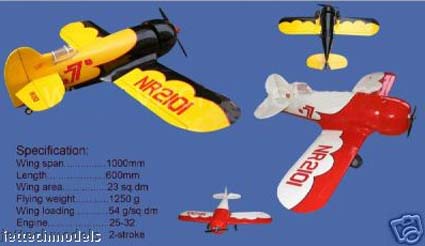
Graphic does not match text from Web site
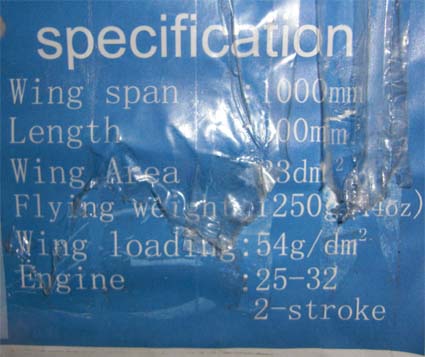
Here is the data from Mark's box.
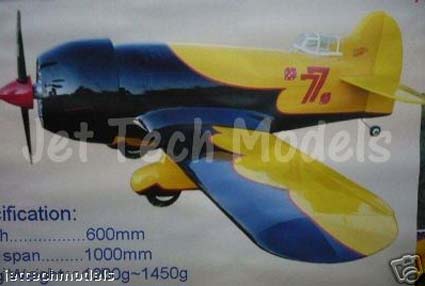
More Info from Web site
The information shown in the Web site graphics match Mark's Known Information. It can also be seen that there is no model designation, other than Gee Bee.
The box notes the wing area as 23 sq dm or 356.5 sq.in., while the Web site meant to note it as 17 sq dm or 263.5 sq.in. That is quite a large difference in wing area on a model of this size.
I spent several days trying to figure out what the actual wing area of the model might be. First, I captured the bottom view of the plane in the upper right of the first photo and imported it into my CAD program. I corrected the angle of the capture and then outlined one wing panel and half of the fuselage and then enlarged the scale of the drawing so that the wingspan was 39.4 inches, actually 1/2 the span of 19.7 inches.
Although the image used was a bit distorted, I found the wing area to be approximately 250 sq.in. or 16.13 sq dm.
I then found a 3-view of the R-1 online, entered it into my CAD program and calculated the scale wing area as 260 sq.in.
Keith Shaw's 50" span model has approximately 400 sq.in. and when reduced to a span of 39.4 inches yields a wing area of 248.4 sq.in.
The full size R-1 is said to have a wing area of 101.9 sq.ft (http://www.airminded.net/geebee/gbr.html). Doing the math to the scale of the model yields 253 sq.in.
Mark sent me a photo of his wing panel. I recalculated the area to be 262.5 sq.in., which is very close to the second given area of 263.5 sq.in. or 17 sq dm.
For the remaining calculations, I have decided to use the wing area or 263.5 sq.in. or 17 sq dm.
Next I recalculated the Known Information and added the CWL/wing cube loading.
The New Known Information
Name: Gee Bee from Flying Model
Wingspan: 1000mm, 39.4 in. - measured by Mark 40.5 in. 1028.7mm
Wing Area: 17 sq dm (being generous), 263.5 sq.in.
Length: 600mm, 23.6 in. - not measured
Flying Weight (advertised): 1250g - 1450g, 44 oz. Ð 51.2 oz.
Area Wing Loading at 44 oz.: 73.4g/dm^2, 24 oz./sq.ft.
Area Wing Loading at 51.2 oz.: 85.4g/dm^2, 28 oz./sq.ft.
CWL/wing cube loading at 44 oz.: 17.8 oz./cu.ft. (Expert piloting skills required)
CWL/wing cube loading at 51.2 oz.: 20.7 oz./cu.ft. (Expert piloting skills required)
Recommended Glow Engine: 25 - 32 stroke
I asked Mark to weigh the components of his kit.
Mark: Here are the weights and measurements you asked for. The heading Hardware includes the weight of the landing gear, screws, etc. It does not include any electronics.
Wings: 10.00 oz.
Wheel covers: 1.70 oz.
Cowling: 1.05 oz.
Fuselage: 10.25 oz.
tail/rudder: 1.45 oz.
Hardware: 6.75 oz.
Total: 31.2 oz. / 885g
Ken: Just the bare airframe has a CWL/wing cube loading of 31.2 oz. / (263.5/144)^1.5 = 12.6 oz./cu.ft. That loading is typical found at the heavy end of advanced sport models and there is no power system or onboard radio system added in yet. Obviously this plane is NOT a park flyer but a scale plane that flies on the wing. This indicates that the Spektrum AR6000 receiver is not a good choice for this model. It requires a full range Spektrum receiver like the AR500 DSM2 5-channel Sport Receiver (0.25 oz./7g).
A good way to estimate the input power required for a sport or sport scale plane that flies on the wing is to double the completed airframe weight and use that as the maximum acceptable ready to fly (RTF) weight. The maximum acceptable RTF weight for this Gee Bee would be 62.4 oz. or 3.9 lb. Multiplying the maximum RTF weight in pounds by 100 watts in per pound yields approximately 400 watts in.
Since this is already a "heavy" plane, a Li-Poly pack would be necessary. For quick calculations I use 3.5 volts under load per Li-Poly cell. That yields 10.5v for a 3S pack and 14v for a 4S pack. If you don't want to use an external switching BEC then 400 / 10.5 = ~38 amps. My preference for a 38 amp draw would be a 3700mAh pack, but because this plane doesn't need any extra weight, I would recommend a pack like the new HYPERION G3 CX 11.1V 3S 3300 MAH 25C/45C 9.7 oz./276g.
www.allerc.com/product_info.php?products_id=4519
With good throttle management, the flight time should be about 7 to 7.5 minutes.
With about a 38 amp draw an ESC like the Phoenix 45 or Thunderbird 54 would be a good choice. The Phoenix 45 weighs 1 oz./28.35g and the Thunderbird 54 weighs 1.2 oz./34g.
400 watts in suggests that the heaviest motor to use might weigh 400 / 1.75 = 239g and the lightest 400 / 3 = 133g for that power. Selecting a motor towards the lighter end of the scale is an important factor for this project.
To allow for 1.5 inches of ground clearance, a 13-inch diameter prop is about as large a prop as possible to use. I calculated this using a front view of the R-1 I found online and then entering it into my CAD program and scaling it.
Using the "New Known Information" from above, the wing loading at 51.2 oz. is 28.8 oz./sq.ft. To find the stall speed in mph the square root of the wing loading is multiplied by 3.7. For this plane, at this weight, it would be about 20 mph. A good stall speed to pitch speed ratio is 3:1 which would be a pitch speed of 60 mph.
If 60 mph were the target pitch speed, then the following would be the required RPM for the various pitches. The pitch table starts with 13 (inches), which is equal to the largest diameter, and goes down to 8, which is about 62% of the diameter. Anything lower would not be acceptable for a plane that is meant to fly on the wing and use air speed more than thrust.
The power out for a decent outrunner SYSTEM (motor+ESC+battery) is about 75% of the power in. 400 watts in times .75 = 300 watts out. The following table was computed using 300 watts out.
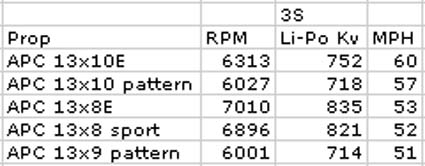
What to look for in a possible motor:
Weight range: 4.7 oz./133g to 8.4 oz./239g (the closer to 133g the better for this plane)
Kv: ~750
Amp draw with an APC 13x10E: ~38 amps
The lightest motor, that I could locate, that had a Kv of about 750 is the Scorpion SII-3020-780. It weighs 166g or 5.86 oz. It is said to be able to handle 40 amps continuous. The prop table at innov8tivedesigns.com/Scorpion/Scorpion%20SII-3020-780%20Specs.htm shows the following:
APC 13x10E, 10.5v, 38.19 amps, 401 watts in, 6350 RPM, Pitch speed 60.1 mph.
I confirmed this using Drive Calculator (www.drivecalc.de) which output:
APC 13x10E, 10.5v, 37.9 amps, 397.9 watts in, 6340 RPM, Pitch speed 60 mph
Finally, I used my spreadsheet (geebee.xls) to estimate the ready to fly weight with the chosen components and to suggest which servos to use. With all of the components mentioned and 3 Hitec HS-82 servos the RTF weight should be about 53 oz. giving it a wing loading of 29.9 oz./sq.ft. and CWL/wing cube loading of 22.4 oz./cu.ft. Typically, anything above 17 oz./cu.ft. is for experts only.
Mark: How is the R at flying? I am flying the parkzone T28 and Corsair with much success and to a lesser extent the parkzone Typhoon 2D (I can fly it, but it is a lot to handle. It is fast and sensitive).
This is getting interesting for me. I have just ordered a wattmeter.
Ken: The R can be a bear to fly. It almost always flips up on its nose during landings. With a CWL of 22.4 oz./cu.ft., it will require expert piloting skills to keep it from doing something nasty. You might want to set this project aside until you are at least very, very comfortable with the Typhoon and have a higher wing loading, low-wing model under your belt.
One of my very best flying buddies, Keith Shaw, an absolutely excellent RC show pilot and real master of the air has an R. He doesn't fly it often, as everything has to be just right, and he has to feel like it is a "good day" for him and the plane. Takeoffs are also a bit "dicey" as the slightest bump will turn it on the ground.
His is just a bit larger than the one you have. His R-1 has a 50" wingspan, with 400 sq.in. of wing area and weighed about 88 oz. when originally powered with NiCads. He has ÒA123Ó 2300mAh cells in it now, and it weighs in at about 74 oz. or about 4.5 lb. It still has a CWL of 16 oz./cu.ft., which is a wing loading of 26.6 oz./sq.ft. and still requires great piloting skill to fly successfully.
Be sure to use that new power meter whenever you set up power systems! Don't ever assume! :-)
Update
Ken, here is an update.
I have decided that I need more stick time before flying this baby, so I will be using this information for my winter project. I have had several planes and the most fun I have is with my Trojan T-28 and Citibria. It looks like I will be purchasing an EPP Stearman (Sport Trainer/3D) from Alpha Foamies. The plane is designed by Jimmie Wade who was kind enough to send me a Real Flight file of the plane. The plane is certainly a little more than I can handle but it is an absolute blast to fly on the simulator and, I believe it is just what I need to get to the next level.
Your newsletter has lots of quality information and is a tremendous help. I can't thank you enough. Best wishes for a pleasant summer and I look forward to speaking with you in the days ahead.
Cheers,
Mark
Return to "What's In This Issue"
Mid-Am Comments, Suggestions and Thanks
Photos and information about the 2009 Mid-America Electric Flies appeared in last month's Ampeer. Here are a few comments and some suggestions.
Hi Ken,
I just wanted to say that I went to the Mid-Am show for the 5th year in a row on Sunday, and enjoyed it as usual. I was just a lowly spectator there. (No such thing! KM) Unfortunately the beautiful near-zero wind of 2005-2007 (at least on the days I attended) hasn't been the case the last 2 years. I like the low-key friendly nature of the event, and the lack of a PA system is a blessing, in my opinion.
My only real suggestion for improvement would be to have a no pop-up zone somewhere, so the spectators can have a decent view. I've noticed RCCD doing this for at least some events. There was a "hole" on the far left when I arrived, but a late arrival pilot unpacked and setup his pop-up there. I noticed a family with 2 young kids sitting on the far left really in the pilot's area, nobody "harassed" them but it made me uneasy safety-wise, having seen lots of crashes over the years. However that was the only place they probably could go to get a decent view.
It may just be my perception, but it seems like the last 2 years there's been more "museum quality" planes, and less simple foamie planes than at the old site, although the wind conditions may be a factor in this. As a park/schoolyard/backyard flier (for 18 years, 5 electric), my planes tend to be more on the ratty flat foam homemade side of things. So although I go to the Mid-Am/RCCD/Skymasters electric events, I haven't flown at one yet. Although I would really like to do the Saturday evening night flying, if I ever get a night flyer built!
I do enjoy reading your Ampeer newsletter from time to time also, I guess mainly when it comes up from a Google search on something battery-related. As an electrical engineer I also enjoy the tinkering side of the hobby, especially with the batteries and motors.
Here's to Mid-Am 2010, let's hope for some low-wind conditions!
Roger Evans
Sterling Heights, MI
evansro@earthlink.net
Hi Ken,
I wanted to thank you, Keith, and all of the members of the Ann Arbor Falcons, EFO, and Midwest R/C that helped bring together another successful Mid America Electric Flies meet. Congratulations on 25 years!! I had a great time flying and taking pictures.
Several people asked where they might find my pictures - they now have a new home, with over 400 pictures from this year - and over 1600 pictures of Mid Am since 2004! They can be viewed at greggallery.gmcdesign.com
(There are also pictures from the NEAT Fair at the same location.)
Feel free to pass along - and enjoy!
Happy Landings,
Greg Cardillo
GMCardillo@att.net
Skymasters R/C of Michigan
Ken,
Please pass this onto Keith as well as I don't have his e-mail address.
I just wanted to thank you and Keith for hosting the 2009 Mid Am.
Your contest really helped me focus on good times with new and old friends during a difficult for me after losing my Dad on 6/30. I had a great time and would have been very happy receiving the plaques let alone the two nice airplane prizes!!
Best Regards,
Denny Sumner
Sometimes a meet is more than just a meet. Thanks for joining us. KM
Hi Ken,
Had a great time at the Mid-AmÕs 25th edition!
Good job!
Don Belfort
And from the Mid-Am 2009 Thread on RC Groups
www.rcgroups.com/forums/showthread.php?t=1047014
To Ken, Keith and all the rest,
Hi there from Toledo! I just wanted to thank all involved in the 2009 MID-AM, We of the Toledo contingent had a delightful day of flying and comradeship. The weather started a bit dicey but by 10 a.m. the skies were blue with some clouds and mild winds, if a bit "crosswindish". There were all kinds of planes from the lightest of the light to seriously heavy metal and everything in between.
Delightful, simply delightful!
Ciao,
Ray Foley
Outstanding Event, yet again. Great site, friends, pilots, weather, planes, and organization.
Thank-you to the Ann Arbor Falcons and EFO's for a great event.
Dave Grife
Great meet - beautiful planes, skillful flying, friendly people, and the hot dogs were pretty tasty too! Hope I can come back next year to fly.
I put some pics up in my blog:
www.rcgroups.com/forums/showthread.php?t=1078360#post12640671
Matt (Esprit440)
Enjoyed the Day
I brought my 15-year-old son and his electrics to the meet (5 planes). We enjoyed the show. He loves to fly and is the future of the RC hobby. But seemed like many that attended didn't appreciate his flying skills or him being there. Kinda sad though, it was the first meet he has attended/flown at, he's been flying less than 1 year (8 months) and was doing very precise rolling harriers in front of the crowd. Yep, he even did rolling harriers with a MS composites Swift 2 too. He's never crashed a plane (which a few more experienced pilots did Saturday. A guy who didn't even know him gave him permission to fly his plane after that- Made my son feel real special. He didn't get any prizes or awards but was by far the best pilot there.
(Yeah, I'm his Dad but he really did put on a good show, when they let him fly- all the way at the end of the field). But I guess the show was more about the quality of the planes than flying.
Like I said, it was a great show and we enjoyed it. But I'm not sure if he will be back next year though, not sure the Mid America flyers are ready for the next generation of RCers' to show up. Kinda sad. Think about.
Joe Smith
My Thanks to Ken Myers & Keith Shaw
I thought the meet was well run by Ken & Keith. They organized a Saturday morning pilots' meeting to make flying rules clear so they/we could accommodate all fliers. Everyone seemed friendly & were able to get along well...there were just a few crashes, with no personal injuries. So...it was a safe, well organized meet with a Saturday evening gathering for pot-luck dinner & generous gifts from the host & sponsors. Both days featured the mid-day flying demos by Keith Shaw and, I was amazed as always.
It was nice to see the "Turbos" model flying family there. They attend every year from the Pittsburg area. They are very friendly people who shared their knowledge of electric models & mechanical expertise with a self-built Ford Taurus station wagon, complete with supercharged engine. Is that cool or what?
I've attended the Mid-America meet for about 6 years now and, I look forward to seeing the next, and next and next. You get the idea.
James Maughan
First one was about 1985? Geeze, I didn't realize that I was that close to attending the first one: I'm thinking the first time I was there was about 1987 (at Saline).
Anyway: weather was much better this year, and the number of aircraft willing to take to the air proved that.
Great event once again, and great to see and talk to everybody again. Kieth has me looking at those A123s: will probably try them in my next project (Jemco Dauntless?)
Anybody get a video and/ or pics of the 'Pair of Mustangs' fly-by on Sunday? Sure would appreciate any leads to such.
Thanks again, Ken & Keith, and everyone else who contributed to this event.
Jim Jager, AKA CorsairJock
Ken,
It was a great weekend. I always enjoy getting together with a group of friends I see only once a year, but it always feels like we flew together just yesterday.
Martin Irvine
Return to "What's In This Issue"
Some E-Planes from Australia
From David Hipperson ritzi2@alphalink.com.au
David wrote to say that he's planning on building an ElectroFlying Fusion. I sent him the unpublished information I have on building and flying mine and he sent back some nice photos and information on a couple of his models. David's name may be familiar to many of you as he write the electric flight column in RCMNews. KM
Dear Ken,
Thanks for your response. The attached articles were very well worth the read. I'm including a couple of photos that may be of interest.

The first may be well known to you and is a Bill Stevens Groove (my second) and running on an AXi 2808/24 with an APC 10x5E APC and 3S 1550 Li-poly. The covering is a mix of Solarfilm Cub Yellow/Blue Profilm Translucent. All up, ready to fly it is 24.6 oz. Flying is superb.
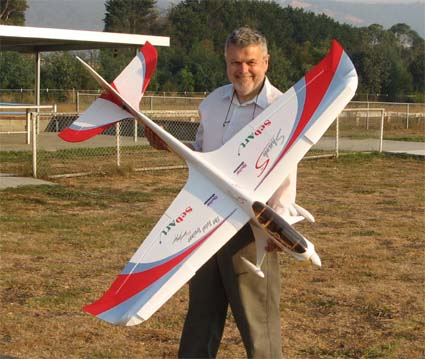
The second is an ARF from Sebart and is the Shark. Designed in Italy by Sebastiano Silvestri but constructed in Asia (somewhere!) to a very high standard. It is an ideal "all-rounder" from Trainer through to knife edge aerobatics all on 3S. The motor is a Hacker A-30 10XL running an APC 14x7E clone which is actually a little better than the APC. Li-polys are 3S 3200 Dualsky 35C. The Shark can be flown in at 18" off the ground and pulled up into a near vertical to roll continually O.O.S. A real honey.
Regards,
David
Return to "What's In This Issue"
How to Convert Li-Polys to Equivalent "A123" Cells
From Brad York eventlogistics@mac.com
Hi Ken,
I am hoping you are able to shed a little light on this old chestnut please. Are you able to tell me if there is a simple (I need all the help I can get!) means to convert from a known amount of Li-Polys which is 5 or 6 cells 5000 mAh times 2 into the number of "A123s" needed to emulate that power setup i.e. 12sp2p. I have read some posts on this and have come up with conflicting views I am hoping you can advise me on this.
Many thanks,
Brad
And My Reply
Hi Brad,
A 5S1P 5000mAh Li-Poly is exactly the same as a 6S2P "A123&qot; 2300mAh pack in voltage and usable mAh. My 6S1P "A123" 2300mAh pack weighs 17.1 oz./484.8g with balance connector & leads and power leads and connectors. That is exactly the same as the 5S1P 4000mAh Li-Poly I replaced it with.
Replacing a 12S1P Li-Poly would require 14 "A123" cells and to get the capacity back to where it was, it would have to be a 2P configuration, thus 28 cells total.
I think with those examples you can see that if you take the number of Li-Poly cells and multiply it by 1.2 it will get you close in regards to the voltage. You'll need to adjust the capacity according to the capacity of the Li-Poly in question.
3 Li-Poly 3.6 "A123" round to 4
4 Li-Poly 4.8 "A123" round to 5
5 Li-Poly 6 "A123" no rounding necessary
6 Li-Poly 7.2 "A123" round to 7
7 Li-Poly 8.4 "A123" round to 8
8 Li-Poly 9.6 "A123" round to 10
9 Li-Polly 10.8 "A123" round to 11
10 Li-Poly 12 "A123" no rounding necessary
11 Li-Poly 13.2 "A123" round to 13
12 Li-Poly 14.4 "A123" round to 14
etc.
Hope this helps,
Ken
Return to "What's In This Issue"
NiCads Aren't Dead Yet
From Randy Smithhisler Randy.Smithhisler@PACCAR.com
I'd received an email from Randy asking about "A123" cells. His most recent email contained the following. KM
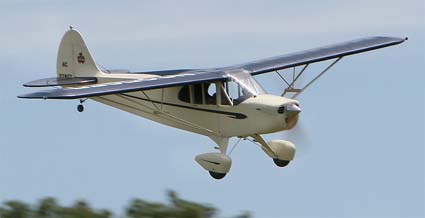
Ken,
Thanks for sending me the Newsletter, I REALLY enjoy reading it.
I just got back from Vernon B.C. Canada (a USSMA Qualifier). I was very fortunate and flew well enough to place 5th. They qualify the top six for the US Scale Masters Championship (so I made it!).
I had debated for a few weeks on what batteries to use for this contest (Nicads, NiMH, Li-Polys, "A123") because my old 2400 NiCads were getting very old. I decide to play it safe and use SR 2400 NICADS. Larry Sribnick makes the best packs available. Wow, am I glad that I did!
The weather at this event was tough (100 degrees and no wind to cool things down). It had to be the worst conditions for an electric model ever. The 36 cells performed great. Another competitor had Li-Polys and they over heated on the second round. He lost power and damaged the model pretty bad.
I used three small exterior cooling fans to cool the motor and pack between flights. Could not have done it without them either.
The attached photo is of my J-4 model.
Take care,
Randy Smithhisler
Return to "What's In This Issue"
One More Mid America 2009 Thank You
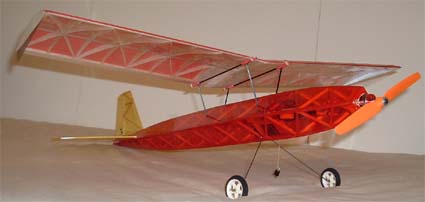
Hello Ken,
Congratulations for putting up another great (as always) fun fly event.
Luckily, I decided to go on Saturday (Sunday was windy up here-I guess it was the same there) and despite the early dark sky and rains, after all, the weather was just great. I began flying at 6:30, when the wind slowed down, and then after the rains were over, and flew several of my planes several times, until 2:30, when the wind began to blow and became too much for my light planes.
It was as much fun as possible. It was great to have the chance to meet all of you great guys. And during the rain, we had the chance to talk, so there was no time lost.
I also had the chance to make new acquaintances, and some of them were very interested in my little planes. One of them was a young man, of about 10 years old, the son of another modeler who was flying a small Hughes racer-very fast. He was watching me and eventually approached me, asking me if I could let him have a hand on my planes. I let him fly one, until he handled back the transmitter to me, about 4 minutes later, and he did very well. After that, he flew several more of my planes.
And this brings us to the point: I think that it could help the hobby to have a trainer available for visitors, family members or kids like this, so they have the chance to enjoy some flying. This could encourage them to get into it. Just a thought.
Thank you, and Keith Shaw, and all the organizers for the great chance to fly with you all.
I am enclosing pictures of my most recent plane: the Aurora. I was flying it that day at 6:00 am before the rain, and later on. As my other planes, it is a sort of free flight nostalgia/fantasy, radio assisted electric.
Its specs are (as flown there with the low-4- aspect ratio wing): 24" ws, 6" chord, 144 sq. in. wing area (1 sq ft), 5 oz. all up weight, (which gives 5 oz/sq ft, or 1 gram/sq in); 10% airfoil, 5% under-camber; 12 grams-18mm diameter C 10 motor (Lucien Miller sells them)-it's about the same as the Park 180-135g thrust; 6/3 GWS prop; Feigao 6a esc; 2x300mah pack; Spektrum AR6000 Rx, DX6 Tx; 2 blue arrow 4.7g servos; carbon fiber pushrods and cabane; Ultrafilm Lite covering on fuse and tail; Solarfilm GM on top of wing and Solite on bottom, and built with Ambroid cement. It flies for some 18 minutes, with 6 to 8 landings. You may find it of interest to your readers.
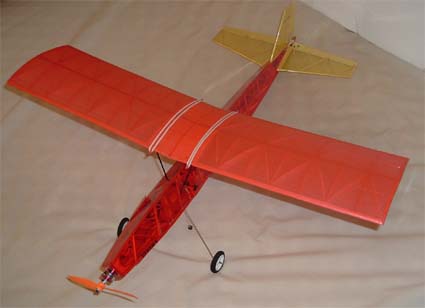
Regards,
Phil Alvirez
Return to "What's In This Issue"
August EFO Flying Meeting
The August 1 flying meeting proved to be quite a flying challenge! While it was a beautiful, sunny day, the winds were 17 mph gusting to 23 mph. Flying was "interesting" to say the least. It was still a great day at the flying field, topped off with a hot dog lunch fixed by and provided by Dave Stacer. Thanks Dave!
I didn't get any photos of the planes being flown, as they should all be familiar to the Ampeer readers now. James Maughan did capture some video of Tom Bacsanyi's new Giant biplane. The video can be found at www.youtube.com/watch?v=GiufXT7Alxc
With lots of flying season left, we are looking forward to our fall flying sessions.
If you have your AMA membership card and a desire to fly with other "electric" folks, come on out and join us on October 10 at the Midwest RC Society 7 Mile Rd. flying field.
Return to "What's In This Issue"
| 









